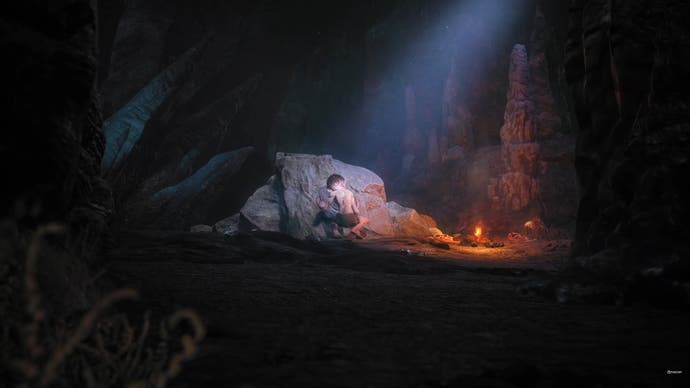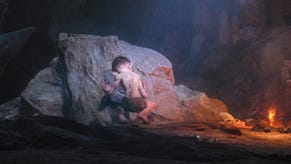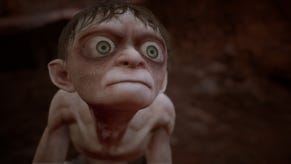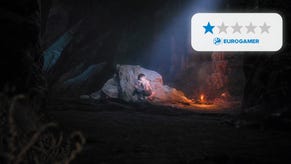The Lord of the Rings: Gollum offers an authentic take on Tolkien's Middle-earth
Precious lore.
Between Amazon's recent Rings of Power series and no less than five games on the way from Embracer, there's a wealth of Lord of the Rings stuff for fans to enjoy. But then, is Tolkien ever really out of fashion?
That includes The Lord of the Rings: Gollum from German studio Daedalic. It's been in development for some time and is due out later this year - I recently visited the Hamburg studio to go hands-on with the game.
Despite inspiring countless video games, only a couple based directly on Tolkien's work have truly stood out. After playing the game, I'm not so sure Gollum will reach the heights of Middle-earth: Shadow of Mordor and its innovative Nemesis system, but it's certainly shaping up to be an authentic take on the original source material that lore enthusiasts will pore over.
That's largely thanks to co-author of the game Damiri Knapheide, the studio's resident Tolkien expert who's in the process of writing a PhD on the author. And he's not so worried about competition from other forthcoming games and media.
"As a fan, I like to see more," he said. "We're definitely coming out this year, but now it's polishing. The other games and movies? I'm not so concerned about them, because we're really in this tunnel, we have to get our thing done and we have to get it to the market.
"I'm happy that it's still something people are interested in. I love Lord of the Rings so obviously I'd love for other people also to show that they are interested and to take inspiration from it."
So why Gollum? After all, by comparison to skilled warriors and powerful wizards, his weak physicality seemingly doesn't immediately lend itself to game design.
Actually a prototype Gollum game was created by a smaller studio which Daedalic took on. "We noticed that was a good choice because we have this timeframe where we have space where we can do our own interpretation," said Knapheide.
"We have this little creature... Gollum, experiencing the world of magic, wonder, evil, good, from a small perspective. He doesn't know it all, he's not the big hero, big fighter.
"He has a lot of problems and he's not a very sympathetic creature, so we made him a bit more cute," jokes Knapheide. "He's suffering and Gandalf has a lot of pity for him and there's a reason for that, because he was just a tortured being and he wasn't a good guy. So basically we tried to make him a bit more sympathetic, show his good side as well."

Gameplay is mostly split into three areas: platforming, stealth, and puzzling.
Platforming, or parkour as Daedalic calls it, has an almost Tomb Raider or Prince of Persia feel to it. Gollum can scamper up walls and along them too, and leaping between platforms is methodical and intentional rather than a twitchy test of speed. Stealth sections are a bit basic - throw rocks to distract enemies, duck under water to avoid their gaze - but have a similarly puzzly sense to them.
And then there are the puzzles themselves. One elaborate sequence had Gollum breeding a specific type of bird, leading me to check wall art for clues on the correct order of events: the right egg colour, the right temperature, the right spot. In all, the game has a pleasingly thoughtful and slow pace in-line with Gollum's character and capabilities.
Unfortunately, that's marred by constant death. Miss a jump or fall off a wall? Death. Get spotted by a beady-eyed elf? Fail. I never felt like I got into the rhythm of the game or was let loose to explore its sometimes gorgeous world. Often there are branching paths giving the illusion of choice - the stealth approach, or the platforming approach - but either way, gameplay is restrictive and almost scripted. Daedalic is so - dare I say - precious about Gollum, to offering a specific experience, it seems afraid to just let players enjoy the world.
.png?width=690&quality=75&format=jpg&auto=webp)
There remains some choice thanks to Gollum's character. Or should that be Smeagol? The duality of the protagonist has been smartly utilised in certain places to provide multiple options on how to proceed. Sometimes this is a quick decision on how to deal with an enemy, but other times not only must players side with either Gollum or Smeagol, they'll only be successful if they convince the other side of the plan, resulting in a short series of dialogue choices that may not always have the desired outcome.
In the short term, the result is alternative dialogue but Daedalic promises wider reaching implications for player choice. I just didn't get to witness that myself in the short preview time.
"People will die, or live," said Knapheide. And players will be able to define the story for themselves. "You can have allies, you can treat people badly, you can lie, you can manipulate. That's what Gollum does."
Really it's the game's authenticity to Tolkien's book world that most impresses. The art style is fresh yet familiar, be it the lush and verdant Elven palaces or the dark interiors of Barad-dûr in Mordor where the eye-shaped architecture suggests Gollum is perpetually watched. That's despite Gollum himself looking similar to his Peter Jackson counterpart, even with his cross eyes.
As Knapheide said, despite the studio being keen to reach fans of both the books and the films, their hands were tied due to legal reasons - the rights to Jackson's films are separate to Tolkien's books.
"We chose to develop our own art style that is more or less Gollum's way to look at Middle Earth," said Knapheide. "So you don't necessarily see the deluxe version of Middle Earth, but you see the deluxe version of Gollum's version of Middle Earth.
"Then our artists chose this kind of style, which is - I think - a more artistic approach that would more fit to a book."
.png?width=690&quality=75&format=jpg&auto=webp)
.png?width=690&quality=75&format=jpg&auto=webp)
In terms of lore, the narrative of The Lord of the Rings: Gollum sits between The Hobbit and The Lord of the Rings. And that both provides a framework for the plot and allows space to play around.
"Although very prominent figures talk about [this timeframe], like Gandalf, he might not know exactly what [happened]," said Knapheide. "In that time Gollum travels and has a lot of experiences and revitalises.
"And of course, we dig deeper - as deep as we can."
He continued: "But of course we tried to stick as closely as possible to [the lore]. For me, this is a hyper, hyper sensitive matter.
"We have to deliver Gollum at the doorstep and say 'ok, now Lord of the Rings main story takes over' because you know that he will follow the company later on. So we have a start and an end. Let's say that this is the definition of the barriers that we have. And within that we can create the story. But it's a sad story, a bit melancholic, and sometimes very touching."
Knapheide admits this is fun to delve into for someone writing a PhD thesis on Tolkien. "It's about imagination, the function of language to create pictures to open up imaginary worlds and centred on The Lord of the Rings," said Knapheide. "Well, if I ever get to finish it!"
The Lord of the Rings: Gollum is set for release on 25th May across PC, PlayStation and Xbox consoles, and Switch.









.png?width=291&height=164&fit=crop&quality=80&format=jpg&auto=webp)